Play, Explore, and Indulge in Puerto Rico
The island’s abundant coastlines, lush rainforests, and creative culinary options lead to sensory-rich encounters and immersive adventures
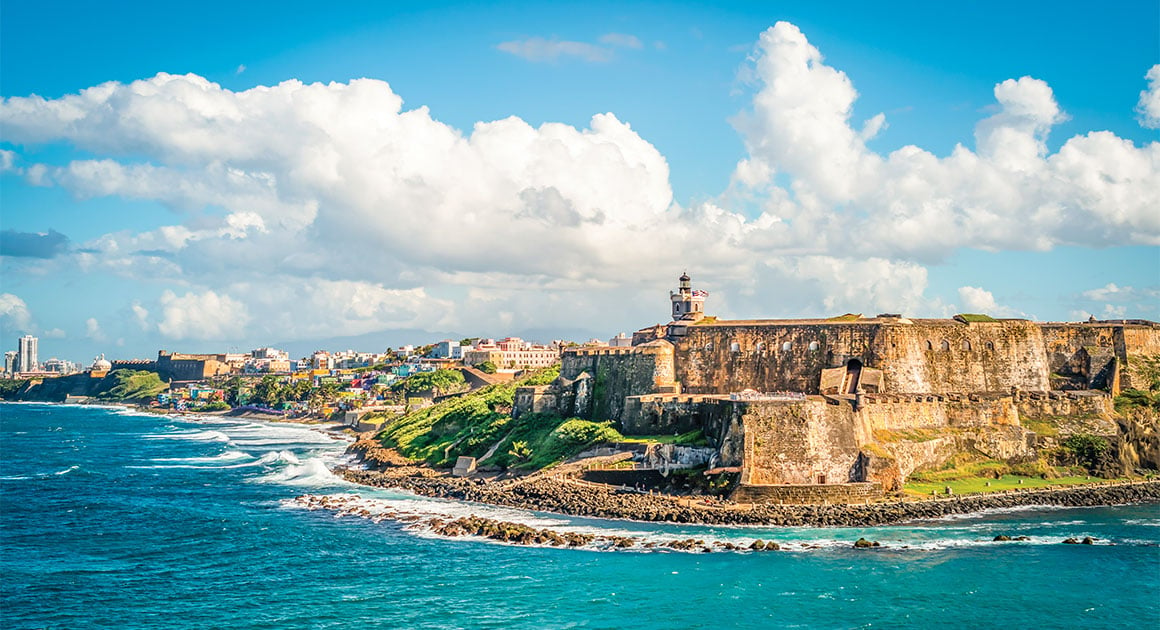
Our power catamaran stops near Isla Caja de Muertos about eight miles off Puerto Rico’s southern coast. Our guide, a marine biologist, lowers a light “snack”
of mackerel in a box on a line to the shallow bottom. Gray nurse sharks soon swish through the aquamarine waters.
In moments, I’ll swim among them.
“Nurse sharks are one of the most friendly sharks to be around and less dangerous than other sharks,” says Giovanni Guzman, owner of BlueKings Puerto Rico, which runs educational snorkeling and scuba excursions. He advises that, when we’re snorkeling with the sharks, we remain calm and avoid splashing or touching the sharks.
Once in the water, I maintain a respectful distance of over 3 yards as I observe
four nurse sharks, each about 7-feet-long, glide by. I swim farther from the boat and spy many small fish, three rays and a green turtle. I’d be smiling at these gorgeous creatures—if it were possible while breathing through a snorkel.
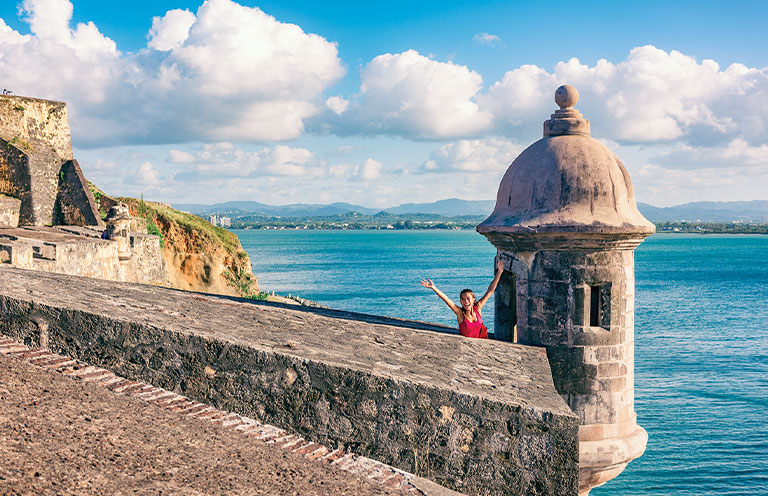
Rich layers of history
It’s my first visit to Puerto Rico, and I’m eager to explore its natural riches, historic areas and layers of culture. Known as Isla del Encanto (Island of Enchantment), Puerto Rico has 300 miles of coastline to play in—with no passport needed for US citizens.
When you include our territories, San Juan, the capital, is the oldest US city, tracing its Spanish roots to 1521. Christopher Columbus stopped by after learning
of its gold and timber riches, and Juan Ponce de León was the island’s first governor. After the Spanish–American War, it became a US territory in 1898. Culturally, the island celebrates its diverse mix of Taino (Indigenous), Spanish and African heritages.
Walking the 500-plus-year-old city streets of Old San Juan, I’m charmed by its cobblestones and brightly colored Spanish colonial architecture. I wander side streets and shaded parks and peer out at the ocean through what remains of the miles of walls that once protected the city from invasion. I stroll the Paseo de la Princesa, a promenade with fountains, and duck in and out of historic churches and beckoning shops. To cool off, I indulge in a piragua, the local version of shave ice with fruit syrup, from a street vendor.
As I wind toward San Juan Bay, a bronze statue of women holding torches aloft captures my attention. La Rogativa pays tribute to a pivotal moment in 1797 when the British navy blockaded the then-Spanish city, and women of the city prayed for divine intervention. With flaming torches, they followed their bishop on a procession through town. Their action fooled the British, who concluded that Spanish reinforcements had arrived and sailed off. I nod respectfully to this inspirational monument to never giving up.

Rainforest wonders
Later in my stay, I join a guided hike through the cloud-capped El Yunque National Forest, the only tropical rainforest in the US. Referred to as the “lungs of Puerto Rico,” the forest is one of the most biodiverse in the US, earning status as a UNESCO Biosphere Reserve with 250 tree species and 140 species of ferns. We take the half-mile Angelito Trail—the forest has over 24 miles of trails in all—to the Rio Mameyes, a designated wild and scenic river.
While it unsurprisingly rains for much of my visit to the rainforest, I love the baptism into this preserve. The cascading waters of falls, streams and rain—along with the two-note “co-Kee” of native coqui frogs—serenade me. Puerto Ricans embrace the 16 species of small but loud coqui as a national symbol. While mainly night singers, some vocalize during the day, especially after rain. I’m surprised by the lack of mosquitos, which our guide, Frankie, attributes to the plethora of frogs, along with lizards and bats, that eagerly eat their larvae.
After our one-mile hike, our guide drives us in a van to several highlights, including Yokahú Tower, a 69-foot circular structure built in the 1960s. After climbing its 98 steps, you can see for 10 miles on a clear day to the coastline and the highest cloud forest. Today, though, a cloud encircles the tower’s top—that is, until we descend and a strong breeze reveals fleetingly blue skies.
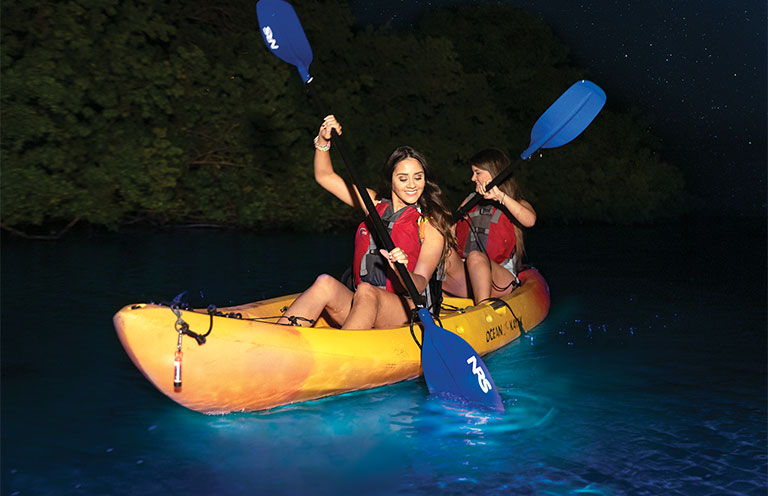
Glow-in-the-dark delights
More wonders await me in Fajardo on the island’s east coast. Puerto Rico has three of the world’s bioluminescent bays: Laguna Grande, Mosquito Bay and La Parguera. The first, aka the big lagoon, is part of a nature reserve and about an hour’s drive from San Juan. During a nighttime Fajardo Bio Bay Kayak tour into Laguna Grande, I paddle for 30 minutes at dusk through a red mangrove channel to enter the lagoon in darkness.
Once the tour group is in the lagoon, our guide advises us to pull the provided blankets over our heads for deeper darkness. I skim my hands through the water, and it glows almost magically. Dinoflagellates, one-celled aquatic organisms, emit blue-green bioluminescence as a defense mechanism. My fellow kayakers and I exclaim in delight. As we head back, the water illuminates as my paddle propels through it.
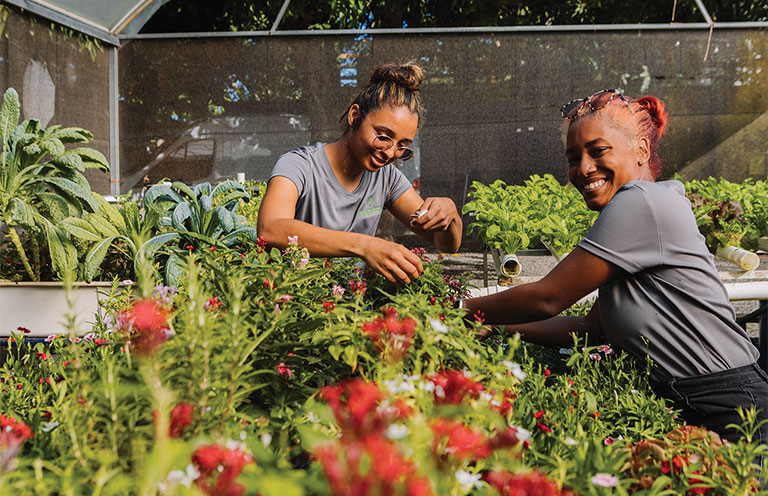
Agricultural and culinary innovations
I wouldn’t usually add “visit a farm” to my vacation to-do list, but an in-the-know friend recommended it. I try to eat local when possible, and my tour of Frutos del Guacabo proves both captivating and delicious. This small farm near the island’s center offers sample-filled foodie tours, along with brunch or lunch with an educational and ecofriendly focus. I’m greeted for brunch with a mimosa followed by the freshest fruit, sliced lechon (pork), avocado toast with confetti coriander,
and tasty scrambled eggs.
Then, owner Efrén Robles leads us through this small (less than one acre) but incredibly productive farm that focuses on hydroponic production. The island mainly imports its food, Robles says, but it has “very good soils and very good microclimates” ideal for farm-to-fork dining and sustainable practices. To that end, Robles has helped to create a network of 50 small farms and connected them with local chefs at 200 hotels and restaurants.
Later, a few of us cuddle and pet the farm’s adorable rabbits and play farmer by helping to milk one of the many goats. It’s not as easy as it looks to extract the liquid. Later, one of the guides demonstrates how to make cheese from the milk. I can’t resist dipping a corn chip into the still-warm cheese served with pickled onions and salsa.
After a few days, I’ve merely skimmed the surface of Puerto Rico’s playtime options, which also include surfing, sky diving and scuba diving. This historic and biodiverse island brims with both land-based and marine treats, which I can’t wait to plunge into again.
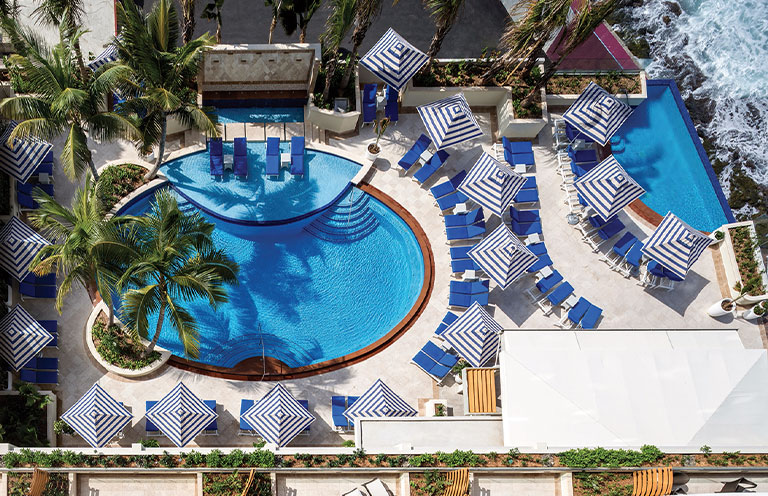
Where to stay
In San Juan, the 317-room Condado Vanderbilt Hotel combines a coastal setting and Spanish revival architecture. Built in 1919, this hotel hosted the rich, famous and powerful during the Roaring ’20s. Dine and sip in style at the restaurant 1919 and submerge in the stunning infinity pool.
About 20 miles west of San Juan, Dorado Beach, a Ritz-Carlton Reserve property, is a 50-acre former Rockefeller estate with 115 rooms that offers e-bike tours, stargazing with telescopes, and guided hikes in search of coquis.
